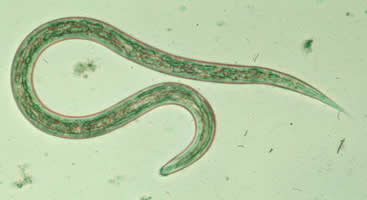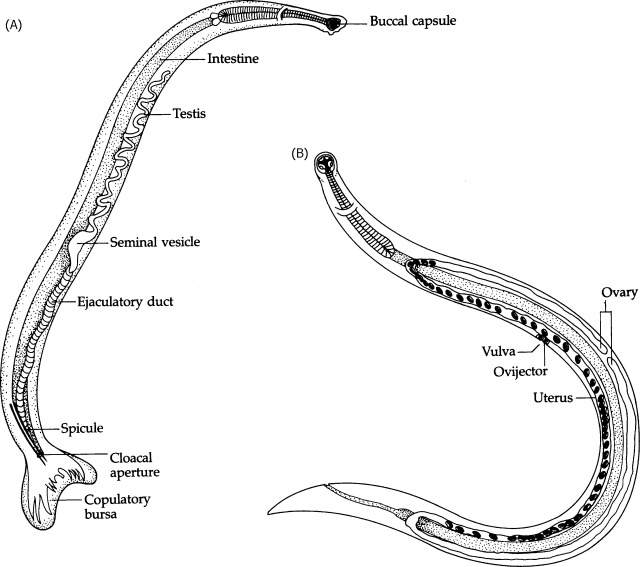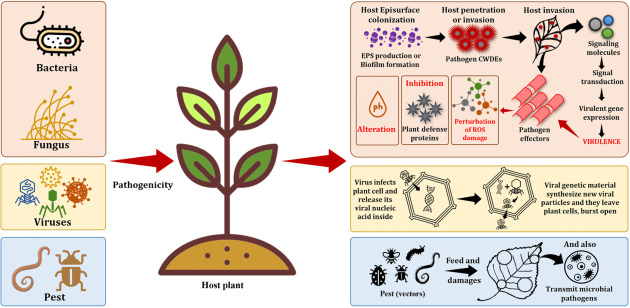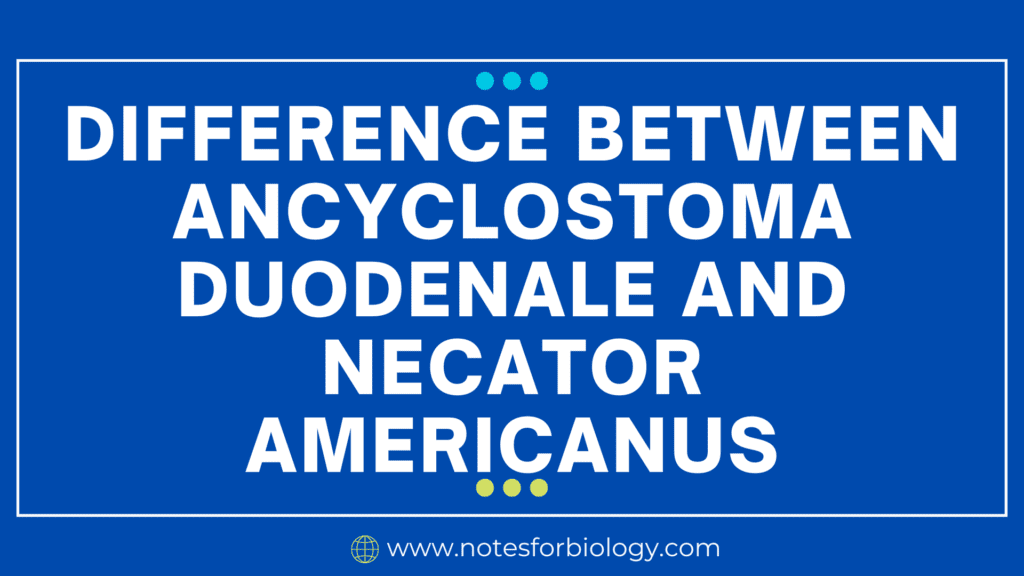Ancyclostoma

Ancuclostoma is a genus of parasitic hookworms that infect the intestines of mammals, including humans. The most common specifies affecting humans is Ancylostoma duodenale.
Table of Contents
Necator americanus

Necator americanus is another species of hookworm that infects the intestines of humans. It is the most prevalent hookworm species worldwide.
Ancyclostoma and Necator americanus
Ancyclostoma and Necator americanus are two genera of parasitic hookworms that infect humans, causing a condition known as hookworm disease or helminthiasis. They belong to the class Nematoda (roundworms) and are primarily known for their ability to cause anemia and other gastrointestinal symptoms in infected individuals.
Difference between Ancyclostoma and Necator americanus
The difference between Ancyclostoma and Necator americanus

| Feature | Ancylostoma(Ancylostoma duodenale) | Necator americanus |
| Geographical Distribution | Southern Europe, Northern Africa, Middle East, India, China, Southeast asia, found in temperate and warm climates | Americas(North, Central, South), Sub-Saharan Africa, Southeast Asia, Australia, – predominantly in tropical and subtropical climates |
| Morphology | Larger body(8-13 mm in length) -Buccal capsule with two pairs of ventral cutting teeth | samller body(7-11 mm in length) – Buccal capsule with cutting plates(lancet – like structures) |
| Infection Mode | Oral ingestion (contaminated food/water) – skin penetration ( often through bare feet) | Primarily skin penetration( through contaminated soil) Rarely through ingestion |
| Lifecycle | Can enter a hypobiotic stage (dormant) in tissues, extending lifespan(1-2 years) Larvae migrate through bloodstream to lungs, then to intestines | Doesnot undergo hypobiosis – Larvae migrate through bloodstream to lungs, then to intestines generally shorter lifespan (1 -3 years) |
| Egg production | Higher egg production up to 30000 eggs a day | Lower egg output up to 10000 eggs a day |
| Disease Symptoms | Severe anemia, abdominal pain, protein malnutrition, ground itch | similar symptoms anemia, abdominal pain, ground itch, but generally less serve |
| Pathogenicity | Causes more significant blood loss generally 0.2 ml per worm per day | Causes less blood loss in essence 0.03 ml per worm per day |
| Host preferences | Primarily infects humans, occasionally animals like dogs and cats (zoonotic potential) | Primarily infects humans, with rare zoonotic transmission |
| Diagnosis | defects of eggs in stool samples – serological tests and PCR for species identification | Similar diagnostic methods stool examination, serological tests, molecular techniques |
| Treatment | Anthelminitics like albendazole and mebendazole – Iron supplements and nutritional support for anemia | Similar treatment albendazole, mebendazole, supportive care for anemia and nutritional deficiencies |
| Buccal capsule Features | Two pairs of ventral cutting teeth | Cutting plates or lancet- like structures |
| Egg shape | Eggs are typically more elliptical and slightly larger | Eggs are slighty smaller and more rounded compared to Ancylostoma |
| Lifespan in Host | Longer lifespan in hunams, up to 1-2 years | Generally shorter lifespan, around 1-3 years |
| Primary infection sites | Prefers upper part of the small intestine | Prefers the middle and lowe parts of the small intestine |
This table shows / highlights the key differences between Ancyclostoma and Necator americanus. emphasizing their geographical distribution, morphological features, modes of infections, and clinical impacts. Both species cause similar symptoms but differ in severity and specific characteristics.
Both Ancyclostoma and Necator americanus are significant public health concerns, particularly in developing countries, due to their impact on health, nutrition, and overall well-being. Ancyclostoma and Necator americanus are typically treated with anthelmintic drugs, such as albendazole or mebendazole, and supportive measures like iron supplementation for anemia.
Frequently Asked Questions
What do you mean by pathogenecity?
The term “pathogenicity” describes a microorganism’s capacity to spread illness, such as that of bacteria, viruses, or fungi. In essence, a pathogen has the ability to make you ill.
Define serological tests?
Serum analysis, or the liquid part of blood left over after blood clotting, is the main focus of serological tests, which are an essential diagnostic tool in medicine. The purpose of these tests is to identify antigens and antibodies, which are important components of the immune system’s reaction to an infection or other stimuli.
Related Articles

